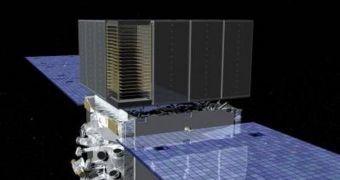Despite the fact that it was only launched less than a year ago, NASA's Fermi X-ray Space Telescope has made a number of significant finds, including a completely new class of pulsars. It has also surveyed gamma-ray bursts that reached our planet from distant times, and peered at X-ray emissions coming from galaxies or black holes billions of light-years away. And, recently, it has also helped shed some light on another cosmic mystery, but this time one a little closer to home.
While speaking yesterday (May 4th) at the annual American Physical Society meeting in Denver, Colorado, Astrophysicist Alexander Moiseev, who is part of the team that manages Fermi, based at the Goddard Space Flight Center, in Greenbelt, Maryland, said that the observatory made some interesting finds about high-energy particles. “Fermi's Large Area Telescope is a state-of-the-art gamma-ray detector, but it's also a terrific tool for investigating the high-energy electrons in cosmic rays,” the expert explained.
One of the main new targets for Fermi were cosmic rays, which surround all galaxies and penetrate deep inside them. For our own Milky Way, some sources were identified as coming from exotic places, such as exploded stars, supernova remnants, and other such formations. Astrophysicists know that these rays are mostly made up of electrons, positrons, and atomic nuclei, traveling at almost the speed of light. The instruments aboard the X-ray observatory are terribly sensitive to electrons and positrons, and the instrument analyzed about 4.5 million such particles between August 4th, 2008, and January 31st, 2009.
A number of scientific experiments over the last year, including the European PAMELA satellite, the High Energy Stereoscopic System (H.E.S.S.) Earth-based observatory and the ATIC balloon-borne experiment, have hinted at unusual energies in the cosmic rays hitting our planet's atmosphere. That is to say, while visible light illuminates with energies of about 2 to 3 electron volts (eV), above us, energies reach as much as 500 billion electron volts (GeV).
“Fermi would have seen this sharp feature if it was really there, but it didn't. With the LAT's superior resolution and more than 100 times the number of electrons collected by balloon-borne experiments, we are seeing these cosmic rays with unprecedented accuracy,” Astrophysicist Luca Latronico, who is a member of the National Institute of Nuclear Physics (INFN), based in Pisa, Italy, explained.
Experts say that the data seems to hint that there exists a nearby cosmic object that emits cosmic rays our way. “If these particles were emitted far away, they'd have lost a lot of their energy by the time they reached us,” INFN Fermi collaborator Luca Baldini added. “Fermi's next step is to look for changes in the cosmic-ray electron flux in different parts of the sky. If there is a nearby source, that search will help us unravel where to begin looking for it,” Latronico concluded.

 14 DAY TRIAL //
14 DAY TRIAL //